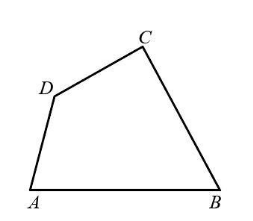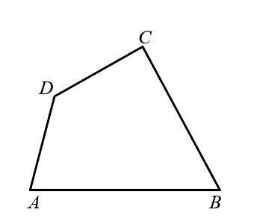
In the figure $ ABCD $ is a quadrilateral. Name a pair of opposite sides.


Answer
573.9k+ views
Hint: We basically define the shape of any object by the number of sides. A quadrilateral can be defined as a plane figure which has four edges and four corners or vertices. The four vertices are $ A $ , $ B $ , $ C $ and $ D $ . These four vertices are such that any three points can never be collinear..
Complete step-by-step answer:

The given figure is a quadrilateral with four sides $ AB $ , $ BC $ , $ CA $ and $ AD $ . The four sides of the quadrilateral are such that they do not intersect each other except the end point. So, in order to find the opposite side of the quadrilateral we will make a pair of the sides which do not share a common endpoint.
The given figure $ ABCD $ is a quadrilateral.
In the figure we will look for the pair of sides which do not share common end points. From the figure we have four sides $ AB $ , $ BC $ , $ CA $ and $ AD $ . The opposite sides are $ \left( {AB,CD} \right) $ and $ \left( {BC,DA} \right) $ as we can see in the figure that there is no common end points between $ AB $ and $ CD $ , and also between $ BC $ and $ DA $ .
Note: The given figure is a quadrilateral. If the quadrilateral were a parallelogram, then the pair of opposite sides must be parallel and equal to each other. The common mistake that can happen is considering a quadrilateral as a parallelogram. Since every parallelogram is a quadrilateral but not all the quadrilaterals are parallelograms. The sides which share a common endpoint are known as adjacent sides. In the given quadrilateral $ \left( {AB,BC} \right) $ , $ \left( {BC,CD} \right) $ , $ \left( {CD,DA} \right) $ and $ \left( {AD,AB} \right) $ are the adjacent sides.
Complete step-by-step answer:

The given figure is a quadrilateral with four sides $ AB $ , $ BC $ , $ CA $ and $ AD $ . The four sides of the quadrilateral are such that they do not intersect each other except the end point. So, in order to find the opposite side of the quadrilateral we will make a pair of the sides which do not share a common endpoint.
The given figure $ ABCD $ is a quadrilateral.
In the figure we will look for the pair of sides which do not share common end points. From the figure we have four sides $ AB $ , $ BC $ , $ CA $ and $ AD $ . The opposite sides are $ \left( {AB,CD} \right) $ and $ \left( {BC,DA} \right) $ as we can see in the figure that there is no common end points between $ AB $ and $ CD $ , and also between $ BC $ and $ DA $ .
Note: The given figure is a quadrilateral. If the quadrilateral were a parallelogram, then the pair of opposite sides must be parallel and equal to each other. The common mistake that can happen is considering a quadrilateral as a parallelogram. Since every parallelogram is a quadrilateral but not all the quadrilaterals are parallelograms. The sides which share a common endpoint are known as adjacent sides. In the given quadrilateral $ \left( {AB,BC} \right) $ , $ \left( {BC,CD} \right) $ , $ \left( {CD,DA} \right) $ and $ \left( {AD,AB} \right) $ are the adjacent sides.
Recently Updated Pages
Master Class 8 Social Science: Engaging Questions & Answers for Success

Master Class 8 Maths: Engaging Questions & Answers for Success

Master Class 8 Science: Engaging Questions & Answers for Success

Class 8 Question and Answer - Your Ultimate Solutions Guide

Master Class 8 English: Engaging Questions & Answers for Success

Why are manures considered better than fertilizers class 11 biology CBSE

Trending doubts
What is BLO What is the full form of BLO class 8 social science CBSE

Which one of the following groups comprises states class 8 social science CBSE

Citizens of India can vote at the age of A 18 years class 8 social science CBSE

Full form of STD, ISD and PCO

A couple went for a picnic They have 5 sons and each class 8 maths CBSE

Right to vote is a AFundamental Right BFundamental class 8 social science CBSE




